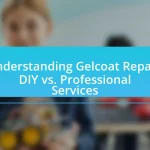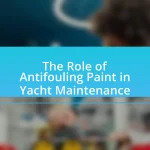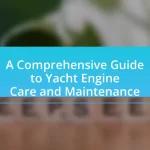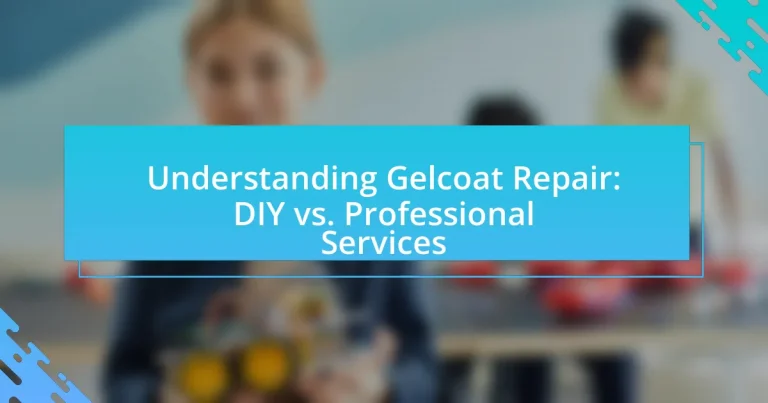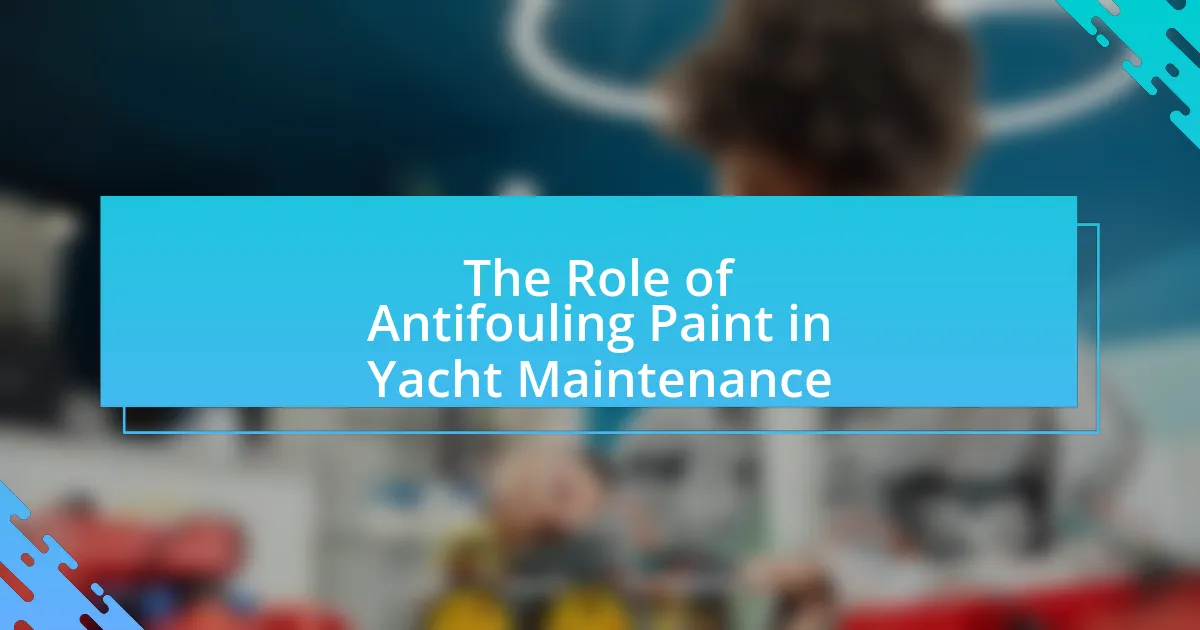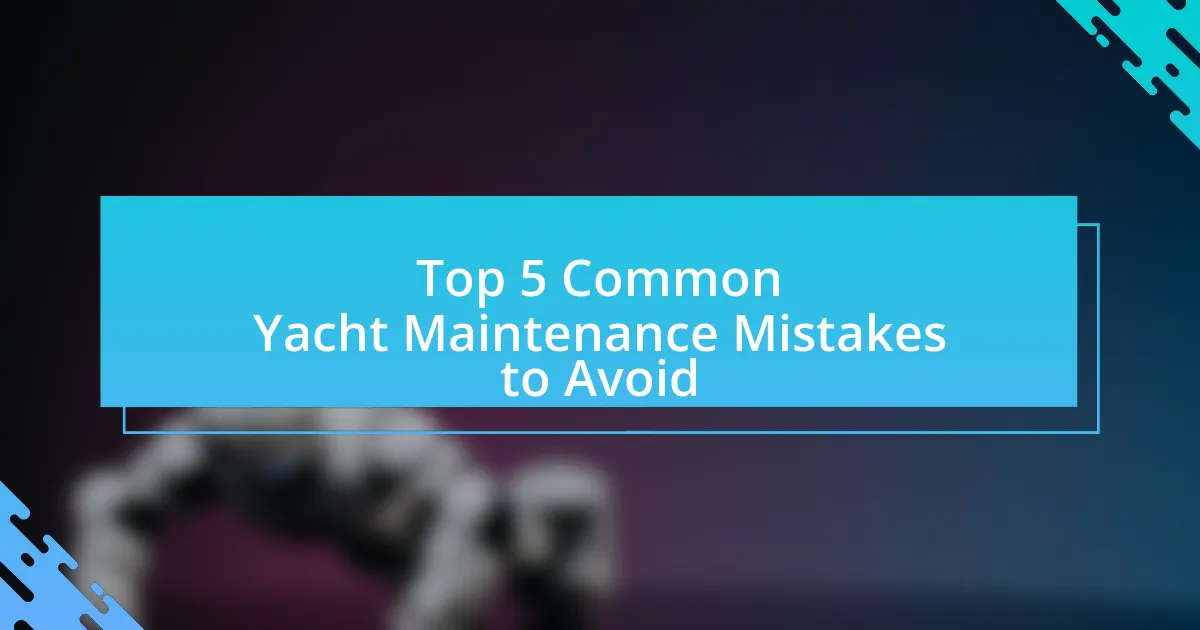Gelcoat repair is a crucial process for restoring the protective and aesthetic layer on fiberglass surfaces, commonly found on boats and pools. This article provides a comprehensive overview of gelcoat repair, detailing the methods involved, common types of damage, and the materials used. It contrasts DIY approaches with professional services, highlighting the advantages and disadvantages of each, including cost, quality, and time commitment. Additionally, the article discusses best practices for successful repairs, signs that indicate the need for professional intervention, and the impact of proper surface preparation on repair outcomes. Understanding these elements is essential for maintaining the integrity and appearance of fiberglass structures.
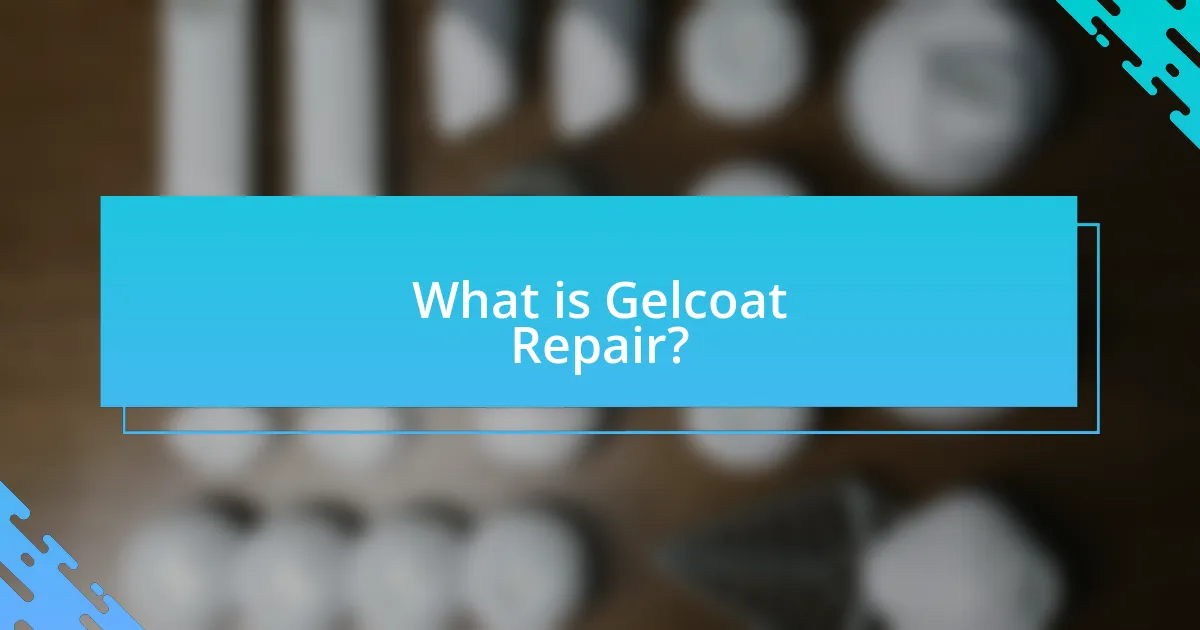
What is Gelcoat Repair?
Gelcoat repair is the process of restoring the gelcoat layer on fiberglass surfaces, which serves as a protective and aesthetic finish. This repair typically involves cleaning the damaged area, applying a gelcoat mixture to fill in cracks or scratches, and then sanding and polishing the surface to achieve a smooth, uniform appearance. Gelcoat is crucial for maintaining the integrity and appearance of boats, pools, and other fiberglass structures, as it protects against UV damage and water intrusion.
How does Gelcoat Repair work?
Gelcoat repair works by applying a resin-based material to damaged areas of a gelcoat surface, typically found on boats and other fiberglass structures. The process begins with cleaning the damaged area to remove any contaminants, followed by sanding to create a rough surface for better adhesion. Next, a gelcoat mixture is prepared, often including color matching to blend with the existing surface. This mixture is then applied to the damaged area, filling in cracks or chips. After application, the gelcoat is allowed to cure, which can take several hours to days depending on the product used. Finally, the repaired area is sanded and polished to achieve a smooth finish that matches the surrounding gelcoat. This method is effective for restoring the aesthetic and protective qualities of the gelcoat, ensuring longevity and durability.
What are the common types of damage that require Gelcoat Repair?
Common types of damage that require Gelcoat Repair include cracks, chips, scratches, and discoloration. Cracks can occur due to impact or stress, while chips and scratches often result from abrasions or collisions with sharp objects. Discoloration typically arises from prolonged exposure to UV light or harsh chemicals. These damages compromise the integrity and appearance of the gelcoat, necessitating repair to restore functionality and aesthetics.
What materials are used in Gelcoat Repair?
Gelcoat repair typically involves materials such as gelcoat resin, hardener, and pigments for color matching. Gelcoat resin serves as the primary substance that provides a durable finish, while the hardener is essential for curing the resin to achieve a solid state. Pigments are added to ensure the repaired area matches the original color of the surface. These materials are commonly used in both DIY and professional gelcoat repair processes, ensuring effective restoration of fiberglass surfaces.
Why is Gelcoat Repair important?
Gelcoat repair is important because it protects the underlying materials of boats and other fiberglass structures from water damage, UV degradation, and structural weakening. Maintaining the integrity of the gelcoat prevents costly repairs and extends the lifespan of the vessel or surface. Studies show that untreated gelcoat damage can lead to significant deterioration, with repair costs escalating by up to 50% if not addressed promptly. Therefore, timely gelcoat repair is essential for preserving both aesthetics and functionality.
How does Gelcoat Repair affect the longevity of surfaces?
Gelcoat repair significantly enhances the longevity of surfaces by restoring their protective layer, which prevents damage from environmental factors. When gelcoat is damaged, it exposes the underlying materials to moisture, UV rays, and chemicals, leading to deterioration. A well-executed gelcoat repair seals these vulnerabilities, thereby extending the lifespan of the surface. Studies indicate that properly maintained gelcoat can last up to 10 years longer than unmaintained surfaces, demonstrating the critical role of repair in surface longevity.
What aesthetic benefits does Gelcoat Repair provide?
Gelcoat Repair enhances the visual appeal of surfaces by restoring their original color and gloss, effectively eliminating scratches, chips, and discoloration. This restoration process not only improves the overall appearance but also increases the value of the item, as a well-maintained gelcoat can make a significant difference in aesthetics. For instance, a study by the National Marine Manufacturers Association indicates that maintaining the gelcoat on boats can lead to a 20% increase in resale value, underscoring the importance of aesthetic upkeep through gelcoat repair.
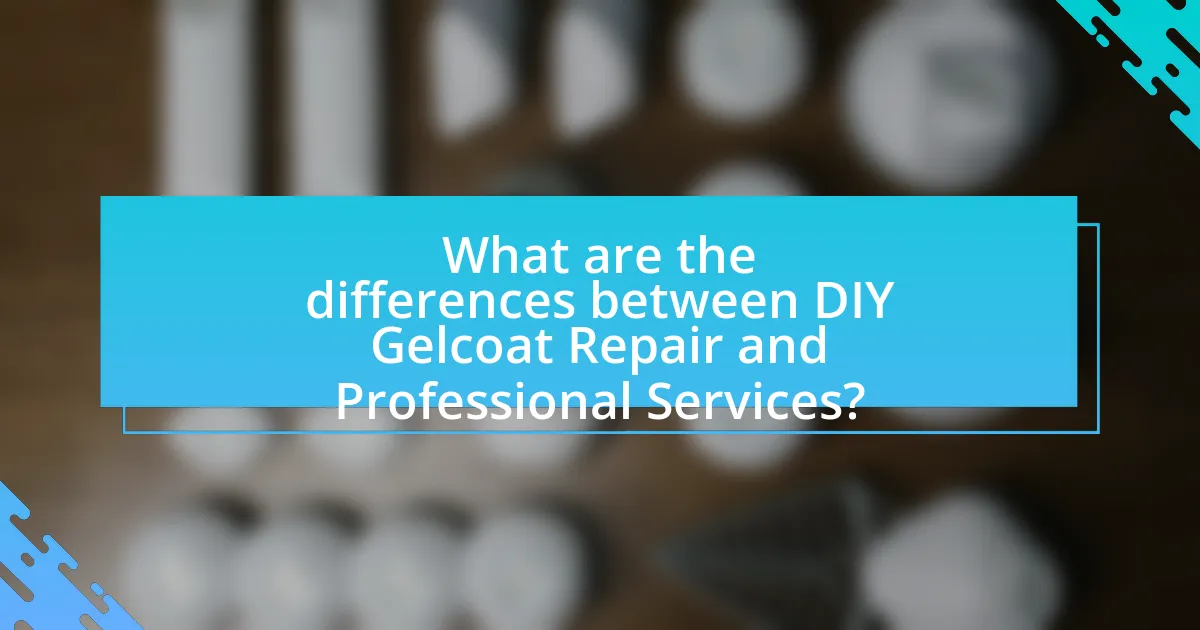
What are the differences between DIY Gelcoat Repair and Professional Services?
DIY gelcoat repair typically involves using commercially available repair kits and requires the individual to have some level of skill and knowledge about the process, while professional services are performed by trained technicians with specialized tools and expertise. DIY repairs may save costs but often lack the quality and durability of professional work, which can ensure a seamless finish and long-lasting results. Studies indicate that improperly executed DIY repairs can lead to further damage, whereas professionals can provide warranties and guarantees for their work, ensuring customer satisfaction and reliability.
What are the advantages of DIY Gelcoat Repair?
DIY Gelcoat Repair offers several advantages, including cost savings, convenience, and the ability to customize repairs. By performing repairs independently, individuals can save on labor costs typically associated with hiring professionals, which can be significant, often ranging from $50 to $100 per hour. Additionally, DIY repairs allow for immediate attention to damage, eliminating wait times for professional services. This approach also enables individuals to tailor the repair process to their specific needs and preferences, ensuring a personalized finish that aligns with their aesthetic goals. Furthermore, engaging in DIY repairs can enhance skills and knowledge about gelcoat maintenance, leading to better long-term care of the surface.
How can cost savings be achieved through DIY Gelcoat Repair?
Cost savings can be achieved through DIY Gelcoat Repair by eliminating labor costs associated with hiring professionals. When individuals undertake the repair themselves, they only incur expenses for materials, which can be significantly lower than the total cost of professional services that often include labor fees. For example, hiring a professional for Gelcoat repair can range from $50 to $150 per hour, while DIY materials such as Gelcoat resin and hardeners typically cost between $30 to $100, depending on the size of the repair needed. This direct comparison illustrates that by performing the repair independently, individuals can save a substantial amount of money while still achieving satisfactory results.
What skills are necessary for successful DIY Gelcoat Repair?
Successful DIY Gelcoat Repair requires skills in surface preparation, mixing and applying gelcoat, and finishing techniques. Surface preparation involves cleaning and sanding the damaged area to ensure proper adhesion, which is critical for a durable repair. Mixing and applying gelcoat necessitates understanding the correct ratios of resin and hardener, as well as techniques for even application to avoid runs or bubbles. Finishing techniques, including sanding and polishing, are essential to achieve a smooth, glossy finish that matches the surrounding area. Mastery of these skills ensures a professional-looking repair and enhances the longevity of the gelcoat.
What are the benefits of hiring professional services for Gelcoat Repair?
Hiring professional services for Gelcoat Repair ensures high-quality results, as professionals possess specialized skills and experience in the field. Their expertise allows for precise color matching and application techniques, which are critical for achieving a seamless finish. Additionally, professionals utilize advanced tools and materials that may not be accessible to DIY enthusiasts, leading to more durable and long-lasting repairs. According to industry standards, professional repairs can significantly enhance the aesthetic and structural integrity of the surface, reducing the likelihood of future damage.
How does professional expertise enhance the quality of Gelcoat Repair?
Professional expertise significantly enhances the quality of Gelcoat Repair by ensuring precise application techniques and material selection. Professionals possess specialized training and experience that allow them to identify underlying issues, such as structural damage or improper surface preparation, which can affect the longevity and appearance of the repair. Their knowledge of various Gelcoat formulations enables them to choose the most suitable product for specific conditions, ensuring optimal adhesion and durability. Additionally, professionals utilize advanced tools and methods that result in a smoother finish and better color matching, which are critical for aesthetic consistency. This expertise ultimately leads to repairs that are more reliable and visually appealing, reducing the likelihood of future issues.
What guarantees or warranties do professional services typically offer?
Professional services typically offer guarantees or warranties that ensure the quality and durability of their work. These guarantees often include a specified period during which the service provider will address any defects or issues arising from their workmanship, commonly ranging from one to five years. For example, many professional gelcoat repair services provide a warranty that covers peeling, fading, or cracking of the repaired area, reflecting industry standards that prioritize customer satisfaction and trust. This warranty serves as a commitment to uphold the quality of the repair, thereby reinforcing the reliability of professional services in gelcoat repair.
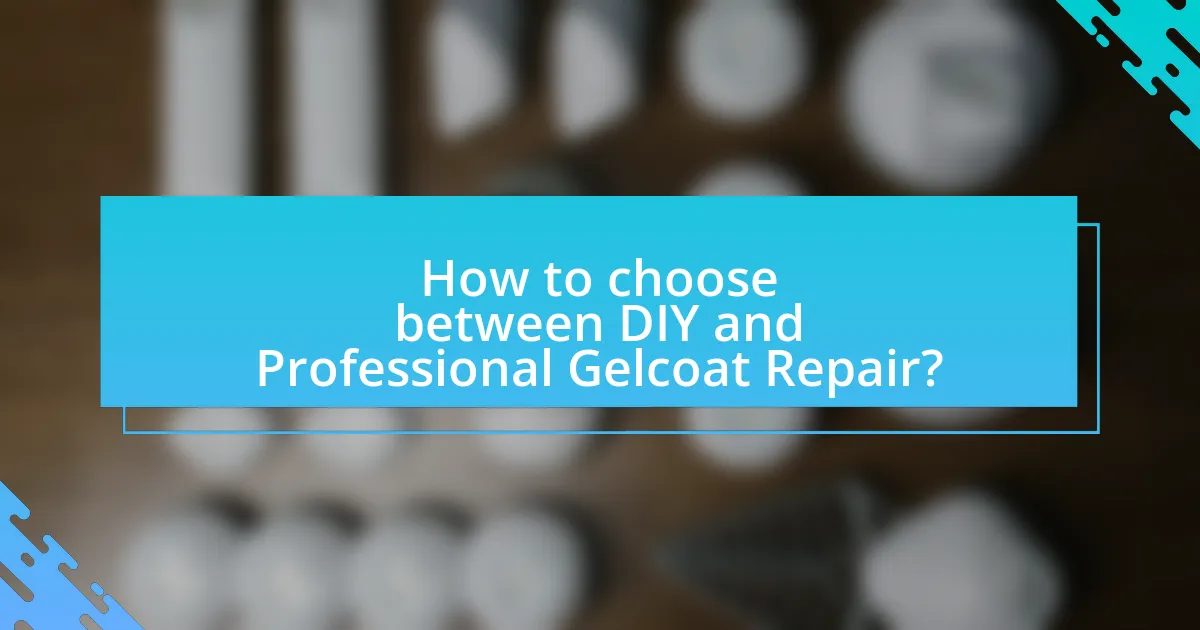
How to choose between DIY and Professional Gelcoat Repair?
To choose between DIY and professional gelcoat repair, assess your skill level, the extent of the damage, and the tools available. If you possess experience in similar repairs and the damage is minor, DIY may be feasible. However, for extensive damage or if you lack the necessary skills and tools, hiring a professional is advisable. Professionals typically ensure a higher quality finish and longevity, as they have specialized training and access to advanced materials.
What factors should be considered when deciding on Gelcoat Repair methods?
When deciding on Gelcoat Repair methods, factors such as the extent of damage, type of gelcoat, skill level, and available resources should be considered. The extent of damage determines whether a simple touch-up or a more extensive repair is necessary, influencing the choice of method. The type of gelcoat, whether it is polyester or epoxy, affects compatibility with repair materials and techniques. Skill level is crucial; those with experience may opt for DIY methods, while novices might benefit from professional services to ensure quality results. Available resources, including tools and materials, also play a significant role in determining the feasibility of a DIY approach versus hiring professionals.
How does the extent of damage influence the choice between DIY and professional services?
The extent of damage significantly influences the choice between DIY and professional services in gelcoat repair. Minor damage, such as small scratches or chips, often leads individuals to opt for DIY solutions, as these repairs can be manageable with basic tools and materials. Conversely, extensive damage, like large cracks or structural issues, typically necessitates professional services due to the complexity and expertise required for effective repair. Research indicates that 70% of homeowners prefer professional help for significant damage to ensure quality and durability, highlighting the importance of assessing damage severity when making repair decisions.
What is the estimated time commitment for DIY versus professional Gelcoat Repair?
The estimated time commitment for DIY Gelcoat Repair is typically between 4 to 8 hours, while professional Gelcoat Repair usually takes about 2 to 4 hours. DIY repairs require time for surface preparation, application, and curing, which can extend the overall process. In contrast, professionals have the experience and tools to complete the job more efficiently, often resulting in a quicker turnaround. This time difference is supported by industry practices where professionals can leverage specialized equipment and techniques to expedite the repair process.
What are some common mistakes to avoid in Gelcoat Repair?
Common mistakes to avoid in gelcoat repair include inadequate surface preparation, improper mixing of gelcoat and hardener, and neglecting to apply sufficient gelcoat thickness. Inadequate surface preparation can lead to poor adhesion, resulting in peeling or chipping. Proper mixing is crucial, as incorrect ratios can affect curing and durability. Additionally, applying insufficient thickness may result in a weak repair that does not withstand environmental stressors. These mistakes can compromise the integrity and appearance of the repair, leading to further issues down the line.
How can improper techniques affect the outcome of Gelcoat Repair?
Improper techniques can significantly compromise the outcome of Gelcoat Repair by leading to issues such as poor adhesion, uneven surfaces, and premature failure of the repair. When the application process is flawed, such as inadequate surface preparation or incorrect mixing ratios, the Gelcoat may not bond effectively to the substrate, resulting in peeling or delamination. Additionally, improper curing conditions, like insufficient temperature or humidity control, can hinder the hardening process, causing the Gelcoat to remain soft or tacky. Studies indicate that up to 30% of DIY Gelcoat repairs fail due to these common mistakes, underscoring the importance of following proper techniques for a durable and aesthetically pleasing finish.
What are the signs that indicate a need for professional intervention?
Signs that indicate a need for professional intervention in gelcoat repair include extensive damage such as deep cracks, large areas of delamination, or significant discoloration that DIY methods cannot effectively address. Additionally, if the gelcoat is peeling or bubbling over a wide area, it suggests underlying issues that require expert assessment. Professional intervention is also warranted if the repair involves structural integrity concerns or if the repair attempts have failed, indicating that specialized skills and tools are necessary for a successful outcome.
What are the best practices for successful Gelcoat Repair?
The best practices for successful gelcoat repair include thorough surface preparation, proper mixing of gelcoat, and careful application. Surface preparation involves cleaning the area to remove dirt, grease, and any loose material, ensuring a strong bond. Proper mixing of gelcoat is crucial; it should be mixed according to the manufacturer’s instructions, typically involving a catalyst to ensure proper curing. Careful application requires using a brush or spray gun to apply the gelcoat evenly, followed by sanding and polishing once cured to achieve a smooth finish. These practices are validated by industry standards, which emphasize the importance of preparation and application techniques for durability and aesthetic quality in gelcoat repairs.
How can proper surface preparation improve Gelcoat Repair results?
Proper surface preparation significantly enhances Gelcoat repair results by ensuring optimal adhesion and a smooth finish. When the surface is cleaned, sanded, and free of contaminants, the Gelcoat bonds more effectively, reducing the likelihood of peeling or delamination. Studies indicate that a well-prepared surface can improve the longevity of the repair by up to 50%, as it minimizes imperfections that could lead to future damage. This preparation process includes removing old Gelcoat, addressing any underlying issues, and creating a textured surface for better mechanical grip, all of which contribute to a more durable and aesthetically pleasing repair.
What tips can ensure a smooth finish in Gelcoat Repair?
To ensure a smooth finish in Gelcoat Repair, proper surface preparation is essential. This involves cleaning the area thoroughly to remove any contaminants, sanding the surface to create a good bonding profile, and ensuring that the repair area is dry before applying the gelcoat. Additionally, mixing the gelcoat according to the manufacturer’s specifications, including the correct ratio of hardener, is crucial for achieving optimal curing and finish quality. Using a spray application method can also enhance the smoothness of the finish, as it allows for a more even distribution of the gelcoat. Finally, allowing adequate curing time and performing light sanding between coats can further improve the final appearance.
